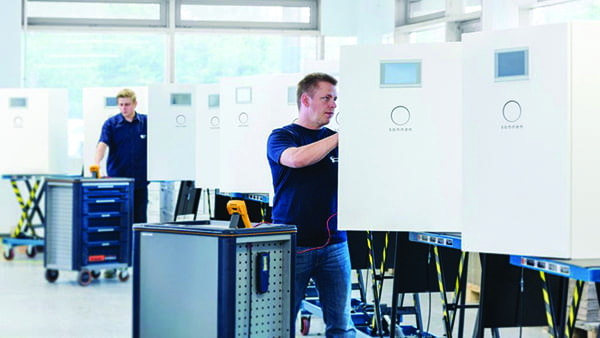A blockchain pilot wrapped up by European transmission operator TenneT and storage solutions provider sonnen Group this May showed “tremendous potential” when used to network decentralized home storage batteries and integrate them into the grid.
The 18-month-long pilot project that was focused on a “three-digit figure” of participating households in northern and southern Germany comprised a TenneT-monitored virtual power station—essentially a network of sonnen-provided home storage systems (Figure 1) equipped with intelligent charge management systems—and Hyperledger Fabric, an open-source blockchain platform. The IBM-developed platform is essentially a distributed ledger designed to facilitate “smart” contracts. As Hyperledger—the open collaboration that is hosted by the Linux Foundation to foster blockchain applications—explains: “Think of it as an operating system for marketplaces, data-sharing networks, micro-currencies, and decentralized digital communities. It has the potential to vastly reduce the cost and complexity of getting things done in the real world.”
 |
|
1. sonnen, a company recently acquired by Shell New Energies, has around 30,000 sonnenBatterie systems in Europe, each with a capacity between 5 kWh and 15 kWh. The total network—which it calls a “virtual battery”—has a capacity of up to 300 MWh, and it has been qualified for participation in the primary operating reserve. Courtesy: sonnen |
In the pilot, sonnen used the private blockchain solution to continually communicate to TenneT how much combined capacity from the home batteries was available for redispatch at specific times. Each time sonnen sent the data, it was recorded in the ledger as an automatically generated “offer.” If TenneT accepted one of these offers, batteries in a region with surplus energy—where there was too much wind power, for example—were automatically recharged with the excess power. To maintain equilibrium, batteries in a region where power was actually needed simultaneously discharged the same amount of power. The real-time documentation in the ledger meant “every kilowatt hour provided—whether stored or discharged—was saved uniquely,” TenneT explained. “Each kilowatt hour received a cryptographic signature for this, which is unique and transparent and which can be used for settlement.”
According to TenneT and sonnen, the pilot showed how blockchain could be effectively applied to stabilize the grid using storage systems, including car batteries. Among the technology’s key benefits are that it establishes a tamper-proof environment where “millions of individual systems are automated so they can be performed with low transaction costs.” Essentially, TenneT said, the system involves a “decentralized data exchange” that is both quick and secure, and which also ensures that individual units can flexibly align with distribution system needs.
TenneT said the pilot is just one of many it is exploring to get the grid “into shape” for challenges posed by the energy transition by 2030. The increasing share of renewables is compounded by more volatility on the demand side. “For example, we now have electric cars whose batteries need charging, but we don’t know exactly where and when that power supply will be needed,” said René Kerkmeester, TenneT Digital Transformation Lead. Congestion and capacity limits pose other issues, and the grid operator says the cost of redispatch, typically passed on to consumers, is now approaching €1 billion annually.
TenneT’s goal is “to develop new ways to control the volatility in a highly weather-dependent electricity system by tapping in to the flexibility that decentralized generation and consumption offer.” That’s why, Kerkmeester said, TenneT is pursuing what he calls a “crowd-balancing” initiative. “We needed a way to manage the electricity flow to and from these small, individual electricity sources. Furthermore, we needed a solution to accurately record and monitor those energy transactions to ensure they actually occur as reported, and to use that information as a basis for payment.”
—Sonal Patel is a POWER associate editor.










